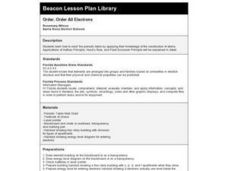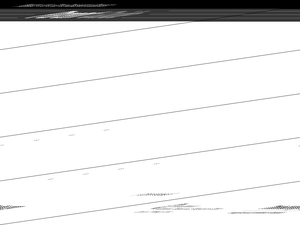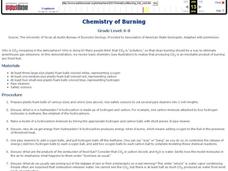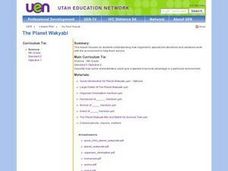Curated OER
Dewey and Chemistry: The Water Cycle Revisited
Students undertake a series of experiments related to the water cycle. All experiments use John Dewey's experiential philosophy as their bases. Each instructional activity is clearly based on philosophy and attempts to be relevant.
Curated OER
It's 'ELEMENT' ary
Learners, using a Web site about the periodic table of elements, create spreadsheets representing elements and their properties. They also create graphs that compare the physical properties of the elements.
Curated OER
Order, Order All Electrons
Students read the periodic table and apply their knowledge of the construction of atoms. They demonstrate reading the electron configuration of an element on the periodic file.
Curated OER
Bonding Basics - Ionic Bonds
For this chemistry worksheet, students complete the chart for each of the listed elements, including the number of protons, electrons, and valence electrons. Then they complete each of the ionic bonds that follows.
Curated OER
Atoms and molecules
In this chemistry worksheet, high schoolers find the words that are related to atoms and molecules. The answers are found by clicking the link at the bottom of the page.
Curated OER
Preservation and the Power of Light
Students identify the effect of light on objects. In this scientific inquiry lesson, students use a chart to write a hypothesis about what will happen when colored construction paper is left in sunlight. Students observe and discuss the...
Curated OER
Chemistry of Burning
Young scholars look into the increase of carbon dioxide in the atmosphere. In this chemistry lesson, students look at the hydrocarbon molecule through a model and see what happens when energy is released. They watch as the water vapor...
Curated OER
Ratio
Students calculate the ratio and apply it to construction. For this geometry lesson, students convert between different units and use decimals and fractions interchangeable. They find the fraction of a given amount using the calculator.
Curated OER
Units in Thermochemical Calculations
Students study how to complete thermochemical equations. In this equation lesson plan students learn how to manipulate equations to calculate energy changes and reactions.
Curated OER
Sugar Bush Sap Production - Human Environmental Impact on Sap Sand
Eleventh graders compare the amount of sugar sand present in tree sap. In this environmental science instructional activity, 11th graders measure different tree circumference. They prepare a report and share findings in class.
Curated OER
Micro-Magic With Sticky Ions
Students view a video about the formation of precipitates. They complete a worksheet that asks them to identify what makes a compound form and what holds it together.
Curated OER
Religion And Magic
Students examine the indigenous religions of China (Daoism) and Japan (Shinto) to see how magical beliefs and practices form an integral part of these religions. This lesson may be controversial.
Curated OER
The Chinese Zodiac And The Western Zodiac
Students create individual horoscopes that contrast and compare Western and
Chinese views of their futures using poster boards and magic markers. In-class discussion is used to evaluate the use of the Zodiac in different cultures.
Curated OER
The Planet Wakyabi
Fifth graders explain how organisms' specialized structures and variations work with the environment to help them survive.
Curated OER
Micro-Reaction Lab: Gas Prouducing Reactions
Students investigate single displacement or double displacement reactions. They have to identify the type of gas produced by filling in the blanks to a data and observation sheet. Also, having to be done is writing balanced equations for...
Other popular searches
- Chemical Symbols for Elements
- Chemical Symbols of Acids
- Chemical Symbols Formula
- Chemical Symbols Elements
- Chemical Symbols Revision
- Writing Chemical Symbols
- Chemical Symbols & Function
- Chemical Symbols Formulae




